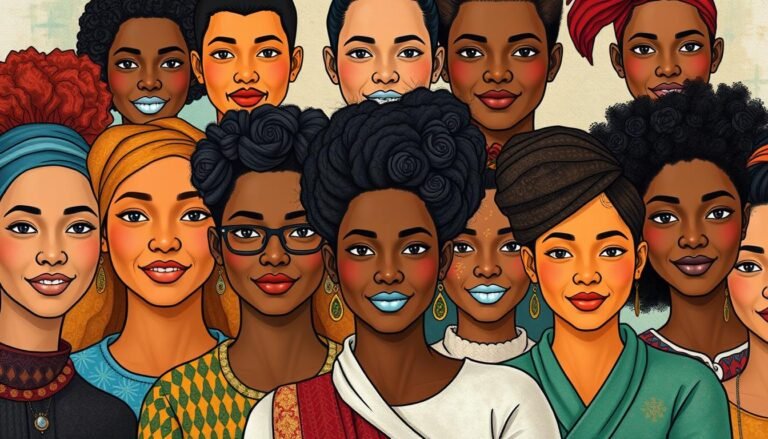Feminist Theory in Sociology: Key Concepts and Theorists
Has the fight for gender equality been won? Not quite. Feminist theory in sociology shows us that the battle is ongoing. It looks at power, social norms, and barriers that affect our society.
Starting in the 18th century, feminist theory gained strength in the 1970s and 1980s. It’s now key for understanding social structures. It fights against patriarchy, questions norms, and pushes for a world where gender doesn’t limit what we can do or be.
In the workplace and classrooms, feminist thinkers reveal hidden inequalities. They show how gender affects education and job chances. They call for changes in policies and practices.
As we look at feminist theory’s main ideas and important thinkers, we see its growth. From liberal feminism to intersectional views, each phase has brought new ideas and challenges.
Let’s dive into the core of feminist theory in sociology. We’ll see its effect on understanding gender equality and its importance today.
Key Takeaways
- Feminist theory in sociology looks at gender inequality and social issues.
- It started in the 18th century but got more popular in the 1970s-80s.
- It fights against male-dominated structures and supports gender equality.
- The theory has changed over time, with each phase focusing on different issues.
- It still tackles issues like the gender pay gap and reproductive rights.
Introduction to Feminist Theory in Sociology
Feminist theory in sociology looks at things from a woman’s point of view. It highlights gender inequality and social issues. This view adds to sociology by bringing in different voices.
Definition and Scope
Feminist theory looks at how gender affects other social factors. It studies power structures and fights for equality. It covers cultural, existential, and phenomenological feminism.
Historical Context
Before, women’s stories were left out of social theory. Feminist theory came to change that. Now, it includes views from all genders, making social theories more inclusive.
Importance in Social Sciences
Feminist theory is key in social sciences. It gives a full view of social forces and issues. It shows how power, gender, race, class, and sexuality all connect.
| Aspect | Contribution to Social Sciences |
|---|---|
| Gender Studies | Analyzes gender differences in social contexts |
| Power Dynamics | Examines patriarchy and structural oppression |
| Intersectionality | Explores overlapping social identities |
| Economic Analysis | Addresses gender wage gap and labor exploitation |
“Feminist theory expanded in the late 20th century to address the globalization of capitalism and its exploitation of women workers.”
Feminist theory keeps growing, tackling issues like LGBTQ+ rights and reproductive justice. Its mix of different fields makes social theory stronger in areas like education and economics.
The Waves of Feminism
Feminist activism has gone through different waves, each focusing on key women’s rights. The first wave started in 1848 and lasted until 1920. It ended with a big win when white women got the right to vote after 72 years of fighting.
The 1960s brought the second wave, dealing with deeper issues. Betty Friedan’s “The Feminine Mystique” sparked a huge debate on gender roles. This era saw laws like the Equal Pay Act and the start of the National Women’s Political Caucus in 1971.
The 1990s saw the third wave, led by Rebecca Walker. It brought up intersectionality, a big idea by Kimberlé Crenshaw. This idea looks at how different social groups are connected.
Now, we’re in the fourth wave, marked by online activism. The #MeToo movement, started by Tarana Burke in 2007, blew up in 2017. It showed how social media can help push feminist causes forward.
| Wave | Time Period | Key Focus | Notable Achievement |
|---|---|---|---|
| First | 1848-1920 | Suffrage | 19th Amendment |
| Second | 1960s-1980s | Workplace rights | Equal Pay Act |
| Third | 1990s-2000s | Intersectionality | Broader inclusivity |
| Fourth | 2010s-Present | Digital activism | #MeToo movement |
Each wave of feminism has added to the previous ones, meeting new needs and broadening women’s rights.
Core Principles of Feminist Theory
Feminist theory in sociology is built on key principles. These principles help us understand social structures and gender oppression. They guide research, analysis, and activism in the field.
Gender Equality
Gender equality is central to feminist theory. It looks at the differences in incomes, education, and career chances between men and women. Feminist thinkers say these differences come from social structures that support male power.
Intersectionality
Intersectionality says different kinds of oppression overlap, affecting people in unique ways. It shows gender oppression is not alone. It also interacts with race, class, and sexuality.
Patriarchy and Power Structures
Feminist theory looks closely at how men hold power over women in society. It shows how gender oppression is part of institutions, cultural norms, and daily life.
| Principle | Focus | Impact on Feminist Epistemology |
|---|---|---|
| Gender Equality | Addressing disparities in income, education, and career | Guides research on gender gaps in various fields |
| Intersectionality | Examining multiple, intersecting forms of oppression | Expands analysis to include diverse experiences |
| Patriarchy Analysis | Uncovering power structures that perpetuate gender oppression | Informs critiques of social institutions and norms |
These core principles of feminist theory help us see and fight gender oppression in society. They give us a special way to look at and fix societal inequalities.
Key Concepts in Feminist Theory
Feminist theory looks at important ideas that help us understand gender roles and social structures. It shows how gender is made by society and affects many parts of our lives.
One main idea is that gender is not just about biology. It says that what society thinks is right or wrong shapes our gender identities. Feminist thinkers believe it’s key to look closely at these ideas.
Another big idea is the sexual division of labor. This means how jobs and tasks are split by gender, at home and at work. Feminists say this division keeps women unequal and limits their chances.
The idea that “the personal is political” is very important in feminist theory. It means our personal lives are linked to big social and political issues. This idea tells us to see how our own lives show bigger problems in society.
| Concept | Description | Impact |
|---|---|---|
| Gender as Social Construct | Gender is shaped by societal norms and expectations | Challenges biological determinism |
| Sexual Division of Labor | Work divided based on gender in home and workplace | Perpetuates inequality and limits opportunities |
| The Personal is Political | Personal experiences linked to broader social structures | Connects individual issues to societal problems |
Feminist theory also talks about how women have been left out and seen as different in societies ruled by men. This idea helps us understand the big obstacles women face and why we need to change society for gender equality.
Feminist Theory in Sociology: Key Concepts and Theorists
Feminist theory looks at how men and women are treated equally and the social structures that affect them. It has grown a lot since it started, with many different views coming up. Let’s look at the main ideas and thinkers that have shaped this field.
Liberal Feminism
Liberal feminism wants to make things fair by improving education and laws. It tries to change social rules from the inside. The Equal Rights Amendment of 1972 was a big step for liberal feminists. It pushed for laws that treat men and women the same.
Marxist Feminism
Marxist feminism says capitalism is the main reason women are treated unfairly. It believes that women do a lot of work without getting paid for it. Marxist feminists think that capitalism helps keep men in power and want to change this for women’s rights.
Radical Feminism
Radical feminism sees patriarchy as the main problem for women. It suggests that women and men should be separate to be equal. Radical feminists often talk about women’s rights, like the Roe v. Wade decision in 1973.
Intersectional Feminism
Intersectional feminism says that women face different kinds of oppression because of their race, class, and other things. This idea, brought up by thinkers like bell hooks, looks at how gender mixes with other parts of a person’s identity.
Important thinkers have shaped these views. Simone de Beauvoir’s “The Second Sex” (1949) talked about how women are seen differently from men. Judith Butler’s ideas on gender have changed how we think about it. These thinkers, along with others, have made feminist theory rich and deep in sociology.
Influential Feminist Theorists and Their Contributions
Feminist philosophers have changed sociology with their bold ideas and studies. They challenged old norms and fought for gender equality. Their work covers many areas, like feminist epistemology and queer theory.
Simone de Beauvoir’s “The Second Sex” started the second-wave feminism movement. Her work showed how society affects women’s lives. Charlotte Perkins Gilman, from 1860 to 1935, wrote “Women and Economics,” looking into gender roles deeply.
Bell hooks linked race, class, and gender together. Her work showed the varied experiences of women. Judith Butler’s studies on gender performativity have been key in queer theory, questioning traditional gender views.
Kimberlé Crenshaw introduced “intersectionality,” showing how discrimination overlaps. Angela Davis looked at how gender, race, and class are linked in oppression.
“What we see as natural differences between men and women are made by society.” – Ann Oakley, 1972
These thinkers have greatly influenced sociology, pushing for a more inclusive view of society. Their work keeps shaping feminist epistemology and helps move towards gender equality.
| Theorist | Key Contribution | Impact on Sociology |
|---|---|---|
| Simone de Beauvoir | “The Second Sex” | Foundation for second-wave feminism |
| Charlotte Perkins Gilman | “Women and Economics” | Multidimensional approach to gender roles |
| Bell hooks | Intersectionality of race, class, and gender | Highlighted diverse women’s experiences |
| Judith Butler | Gender performativity | Crucial in developing queer theory |
| Kimberlé Crenshaw | Coined “intersectionality” | Revealed overlapping forms of discrimination |
Feminist Theory and Social Institutions
Feminist theory shows how social institutions shape gender roles and keep inequality going. It looks at education, work, and family life closely.
Education
Educational equality is a big focus for feminist theory. Even with progress, gender stereotypes in school and career advice still exist. Feminists want education that gives all genders the same power.
Work and Economy
The gender wage gap shows how unequal the workplace is. Women make less money than men for the same job. Feminist theory works to fix this, including fighting against sexual harassment and the glass ceiling that stops women from moving up in their careers.
| Issue | Impact |
|---|---|
| Gender Wage Gap | Women earn 82 cents for every dollar earned by men |
| Glass Ceiling | Only 8.8% of Fortune 500 CEOs are women |
Family and Relationships
Feminist theory questions traditional family roles. It fights for equal sharing of household chores and talks about domestic violence. Work-life balance is key, pushing for policies that help with both career and family.
Looking at these areas, feminist theory shows how they work together to keep gender inequality going. Understanding this is key to making society more fair.
Challenges and Critiques of Feminist Theory
Feminist theory faces big challenges in its use and understanding. Critics say it often ignores cultural and individual differences. It mainly looks at Western, middle-class women’s lives. This has led to the rise of post-feminism, which doubts if feminist theory is still needed today.
Anti-feminism movements argue that the theory focuses too much on men’s power and ignores men who face gender discrimination. They say feminist theory can be too narrow, leaving out transgender people or men facing gender-based issues. These arguments have started discussions on how inclusive and useful the theory is for different groups.
Gender criticism points out the need for a deeper look at gender roles and identities. It suggests that feminist theory should change to understand gender better, beyond just male and female.
“Feminist theory must adapt to include diverse perspectives and experiences to remain relevant in our ever-changing society.”
Despite the challenges, feminist theory keeps growing. The table below shows how feminist thought has expanded and become more diverse:
| Feminist Approach | Key Focus | Notable Contribution |
|---|---|---|
| Black Feminism | Struggles of black women | Intersectionality (Patricia Hill Collins, 1990) |
| Radical Feminism | Male-driven oppression | Analysis of patriarchal systems |
| Lesbian Feminism | Lesbian identity and rights | Concept of compulsory heterosexuality |
| Global Feminism | Worldwide gender inequality | Focus on international women’s issues |
Feminist theory keeps changing and is still a key part of sociology. It challenges old views and works towards a more inclusive view of society.
Contemporary Applications of Feminist Theory
Feminist theory helps us understand social issues today. It looks at the gender wage gap, reproductive rights, and LGBTQ+ rights. These topics show how feminist ideas are still important in our world.
Gender Wage Gap
The gender wage gap is a big issue for feminist activists. Women often make less money than men for the same job. This gap is even bigger for women of color, showing we need to look at equality from different angles.
Reproductive Rights
Reproductive rights are key in feminist theory. They cover access to abortion, birth control, and healthcare for mothers. Feminists fight for the right to control their bodies and make choices about their health.
LGBTQ+ Issues
Queer theory is now a big part of feminist thought. It questions traditional ideas of gender and sexuality. This has made feminist movements include more people with different gender identities and sexual orientations.
Feminist theory also deals with new problems. These include online bullying, feeling good about one’s body, and how social media affects gender roles. By tackling these issues, feminist activism keeps working towards a fairer and more equal world.
“Feminist theory and queer theory have reshaped our understanding of gender and sexuality, pushing us to imagine a more inclusive world.” – Dr. Jane Smith, Gender Studies Professor
Conclusion
Feminist theory has made big steps towards gender equality and social change. It has introduced new areas like sexual harassment and lesbian communities. It has also refreshed topics like mothering and the life cycle.
This shows how feminist views shape our view of society. The theory has made gender-sensitive research common in sociology. Yet, it hasn’t led to big changes as much as other fields. This means there’s still room to grow and change.
Looking ahead, feminist theory in sociology must evolve. It should include diverse views from around the world and look at how technology affects gender. By doing this, it can keep being a key force for change and equality in society.
Source Links
- Feminist Theory – Theoretical Models for Teaching and Research
- Feminist Theory in Sociology: Deinition, Types & Principles
- Feminist Theory: A Summary for A-Level Sociology – ReviseSociology
- Feminist Theory in Sociology
- LibGuides: Social Work Theories: Feminist Theory (Jan 2018)
- Feminist Theory for A Level Sociology: An Introduction – ReviseSociology
- What Are the Four Waves of Feminism? | HISTORY
- Feminist Movements and Feminist Theory
- Reading: Feminist Theory | Sociology
- Feminist Theory and the Social Work Exam | SWTP
- Microsoft Word – 33_forside_mv.doc
- Feminist Theory in Sociology: Deinition, Types & Principles
- No title found
- Feminist theory
- The Feminist Perspective
- Sociological Theory/Feminist Theory – Wikibooks, open books for an open world
- Feminist sociology
- Feminist Theory in Sociology – Sociology Learners
- Feminist Movements and Feminist Theory
- AISW Vol. 8, No. 1:AISW Vol. 5, No. 2
- Feminist Social Theory | Social Theory Rewired: New Connections to Classical and Contemporary Perspectives
- Ask the Sociologist: Feminist Sociological Theory and Conflict Theory
- Feminist Theories (Chapter 8) – The Cambridge Handbook of Sociology
- No title found
- Feminist Theory | Encyclopedia.com
- No title found







